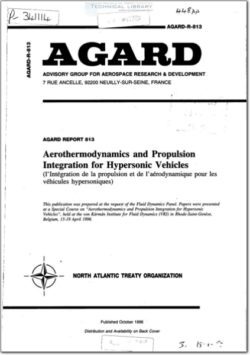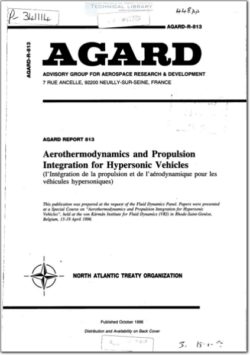AGARD-R-813

- Version
- 294 Downloads
- 35.34 MB File Size
- 1 File Count
- April 25, 2016 Create Date
- April 25, 2016 Last Updated
Aerothermodynamics and Propulsion Integration for Hypersonic Vehicles

After a short general introduction to the topic the objectives of
the course are presented. The background in form of technolo-
gy programmes. development projects and operational vehicles
is sketched, distinguishing four classes of hypersonic vehicles
ranging from aeroassisted(winged)reentry vehicles over air-
brealhing and rocket-propelled space transportation systems to
missiles. The different roles of aerothermodynamics and pro-
pulsion integration in vehicle definition and development work
are identified as well as the evolution needs of these key tech-
nologies. A short discussion of the structure of the course and
the background of the lecturers closes this introduction to the
course.
Hypersonic flight with manned, aeroassisted, rocket-propelled
and/or airbreathing vehicles is since several decades the topic
of technology work all over the world. Sofar it has led to only
one truly operational vehicle. the US Space Shuttle as a space
transportation system. Unmanned aeroassisted hypersonic vehi-
cles are in operation in the military missile realm. they begin
also to enter the space-transportation scene.
Aerothermodynamics and propulsion integration are key tech-
nologies needed for the definition and development of hyperso-
nic vehicles. The term "hypersonic vehicle" is used here in the
widest sense. The major characteristic of these vehicles is that
they are aeroassisted, i.e. winged vehicles, although modern
reentry capsule designs also exhibit elements of aeroassistance.
Hypersonic vehicles. as elements of space transportation sy-
stems, as high-speed earth transportation means and as military
defense, reconnaissance or weapon delivery systems are, with
few exceptions. more or less at the begin of their careers.
Because recently all over the world several large technology
programmes and development projects were performed and
finished (only a few of them are still continuing). and on the
other hand new efforts are only slowly taking off. it was
thought to be timely to organize this special course.
| File | Action |
|---|---|
| AGARD-R-813 Aerothermodynamics and Propulsion Integration for Hypersonic Vehicles.pdf | Download |

Comment On This Post